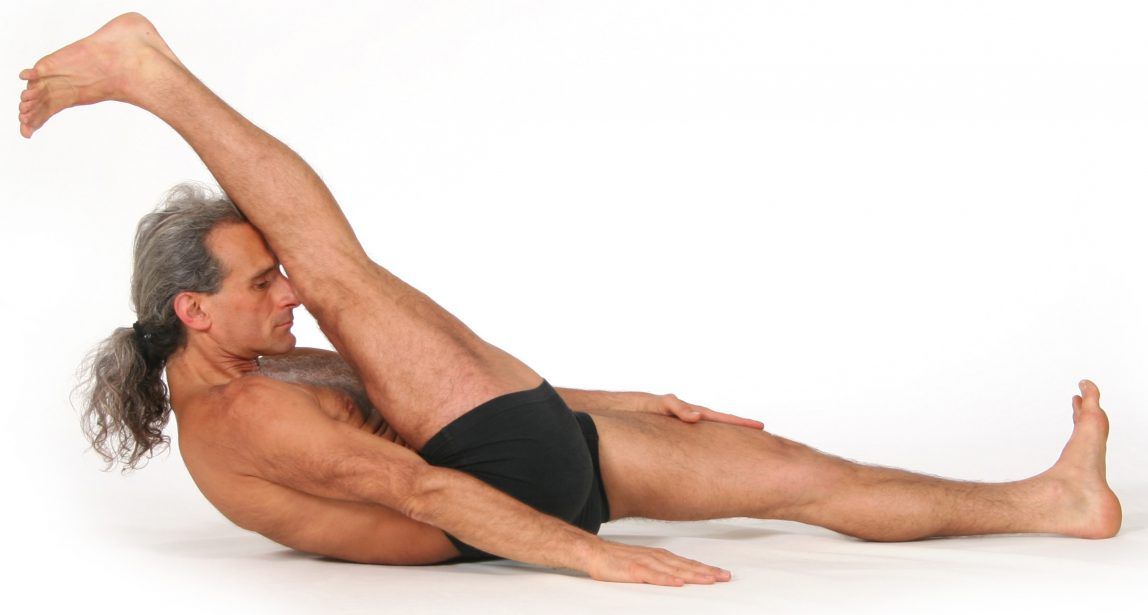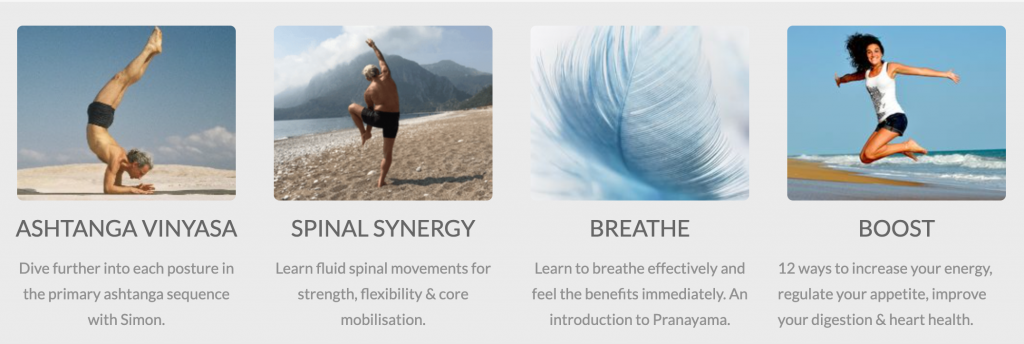Bad diet, an unfocused mind, stressful practice, not using your diaphragm, holding postures too long, over-tensing muscles, not being able to properly activate muscles and abdominal over-breathing can all make your yoga practice ineffective and impede your progress for a lifetime.
We previously posted an article about the basic tenets of the Yoga Synergy Method, which can make any style of yoga effective and beneficial. Some days after that we received a letter from one of our readers saying that despite her 1-2 hour yoga practice, 4 times a week, she is still gaining weight and is not getting stronger.
Dietary issues, when combined with ineffective yoga practice can be depleting and cause one of the two possibilities: weight gain or the inability to put on weight.
Factors affecting weight gain or loss include how much you breathe, in what manner you breathe, how stressful your practice is, how many calories your practice burns, how effective your digestive system is and how well you can activate and relax your muscles.
Over-breathing makes you stressed and over-eat
The body regulates blood pH to stay within the narrow range of 7.35 to 7.45 and one of the ways it does this is by choosing foods that leave a particular pH in the blood
If you breathe more than normal in your practice (hyperventilate), it will tend to raise the pH level of your blood slightly towards alkalinity. To balance that alkalinity you are more likely to crave processed, high protein and/or acidic foods after your practice, which may result in weight increase.
Conversely, if you tend to breathe less than normal in your practice (hypoventilate), you will probably not be hungry after your practice. Carbonic Acid levels in your blood increase as a result of breathing less, lowering your blood pH, making it more acidic. If the blood is slightly acidic then you will feel less like eating, be attracted to more alkaline foods such as fresh fruit, salad and vegetables, and therefore lose weight.
How you breathe
If you tend to breathe naturally into your abdomen using your diaphragm as opposed to breathing more into your chest, your digestive system tends to work more effectively to digest food, absorb nutrients and eliminate waste. However, if you inhibit the diaphragm by always ‘holding in your abdomen’, your digestive system may become dysfunctional. Often people (especially women) tend to hold in their abdomen using muscles of forced abdominal exhalation to try to look slimmer or perhaps to try to stabilize the spine and manage lower back pain.
In our previous blog we explain how to firm your core in a safe stress-free way. If the abdominal exhalation muscles are always in use (to stabilize the back or hold the tummy in) then the abdominal inhalation muscle (the diaphragm) is inhibited and by default chest breathing occurs. In this scenario the autonomic (‘automatic’) nervous system is disturbed and could result in either incorrect absorption of food, which may cause weight loss or incorrect metabolism of food which may lead to weight gain.
Over-breathing should be followed by breath-retention
Sometimes people think that breathing into the abdomen will automatically mean that they do not over-breathe, however this is not the case. If you do a full abdominal breath every 2 or 3 seconds, the amount of air breathed per minute can be as much as 50 litre per minute, which will mean that you are definitely over-breathing compared to the 5 litres per minute that is considered to be normal breathing for a healthy person at rest. Rapid abdominal breaths can be the result of an unfocused mind or stress, which result in a stressful practice that depletes your immune system instead of strengthening it.
Sometimes people consciously do rapid abdominal breathing as part of the kriya (yogic cleansing process) referred to as kapalabhati. This would be appropriate as an occasional practice, but for most people it is best to follow any period of breathing more than normal with a significant period of breathing less than normal. This is what is done in the traditional pranayama practice of bhastrika, which often is done as a period of some type of rapid breathing such as kapalabhati followed by holding the in and/or out for as long as possible. If the breath is not held long enough after kapalabhati, then this usually results in excessive hunger after the practice.
An always relaxed muscles is just as bad as an always tensed one
Another reason you may not lose weight when practicing yoga is because your practice may not be intense enough and you are not using your muscles in an effective way to move your blood. Although advanced yoga practitioners can move their blood (without needing to increase heart rate) in stationary postures, most people can only really increase their circulation with moving exercises. For newer practitioners, therefore, it is better to either move through the postures smoothly and/or to hold some postures for between 10 – 30 seconds. The easiest way for the average person to do this is by having a brisk 30-minute walking meditation every day.
If you feel totally unfocused and emotionally disturbed while practicing, it is good to stop for 5-10 minutes and do a hypoventilation session in a comfortable posture. To do this, simply hold your breath in for 20-30 seconds and/or hold your breath out for 20-30 seconds to calm your mind. If you are unable to comfortably hold your breath at all, then simply return to your most natural minimal breathing.
The art of yoga
Finding the balance between having a relaxed but intense practice is the art of the yoga. You need good self-knowledge (svadhyaya) and honesty (satya) to realize the thin line between doing your best (tapas) and gently pushing your limits to challenge yourself while not over-doing your practice out of greediness.
If it is hard to find a balance within one yoga practice, then do different types of yoga practices: one day a gentle and quick flow of vinyasa practice to enhance blood flow, then perhaps the next day hold the postures longer and try to do some resistance stretching in each posture to gain more strength in a slow flowing practice. You can alternate between these kinds of practice on a regular basis.
For stressed and/or unfocused people, doing a ten-minute long meditation with natural breathing every day first thing in the morning, then slowly increasing the amount of time in meditation can lead up in the long run to a calmer state of mind with which it is easier to find that delicate balance.
Too much eating
There is one other big reason that you may be not losing weight with your practice. You may be eating too much food. As an adult you simply do not have to eat so much. It is important to keep your bowels moving, and so appropriate amounts of fibre containing food are useful to eat, but once you get your bowels moving and take in a sustainable number of calories you simply don’t need to eat any more in that day. If you do eat more that the body can use immediately for energy needs (as an adult who does not need to grow or rebuild any parts) excess food will end up in one of three ways:
- Creation of excess fat in your body
- Act as a mechanical blocking agent in your body
- Become fermented or putrefied by microorganisms inside you
All diets have problems: The only proven diet is the ‘Eat less and you live longer’ diet
All diets have been shown to be faulty. Some people believe an ‘eat only grains’ diet is very good, or the ‘eat only high protein food including meat’ diet is good, but there’s scientific evidence both for and against both these views. In fact all diets have pros and cons, and the scientific evidence for almost every diet in the world is not conclusive.
The only diet that does have some scientific backing is the ‘eat less diet’.
Technically it is called the ‘calorific reduction diet’. It has been shown repeatedly in studies over more than one hundred years that if you eat less you live longer. In animal studies this is true whether using very small animals or large ones. For example, in one experiment a group of mice were allowed to eat as much as they wanted to. A basket of food was left open and they helped themselves, and then the amount of food they consumed was measured. A second group of mice were fed just a quarter of this amount, and the second group lived two or three times longer than the first.
This increased longevity is probably due to reduction of free radical production, decreased production of highly damaging forms of oxygen and less stress on the cells metabolism due to ‘overuse’. Overuse wears anything out, so when you put less food inside yourself (provided your body functions ok), it results in less stress on the system.
The most effective way to learn to comfortably eat less to increase health is as follows. Increase the proportion of alkalising food in your diet (such as fresh fruit and vegetables). At the same time compensate for the increased alkalinity by breathing less to increase the levels of carbon dioxide and carbonic acid in the body.
In short if you breathe less while still being able to exercise and practice your yoga etc. (i.e. get physically fit – e.g. be able to exercise harder without panting and/or be able to do good pranayama – e.g. work towards being able to breathe less than one full breath per minute at rest). Then you will generally find you are just not that hungry, yet you are energised and so your desire and need to eat will be less and this is the ultimate way to lose weight
Try a FREE Lecture
To learn more about this material please join one of our online courses. Try a FREE Lecture from any of our courses.
Advanced Yoga Fundamentals: Essentials for Teaching Yoga
Blending the science of physiotherapy and traditional yoga, you will learn the practical application of our ‘Anatomy and Physiology of Yoga’ course. For most people this is a more practical and more accessible course than ‘Anatomy and Physiology of Yoga’ and we recommend you do it first.
Our online course ‘Yoga Fundamentals:Essentials of Teacher Training: is a good complementary course for the ‘Anatomy and Physiology of Yoga’ Course as it’s not enough to know where your muscles and bones are, you also have to know what to do with them!
This is the public version of the award winning RMIT university course.
Our online course ‘Anatomy and Physiology of Yoga’ compares and contrasts the Eastern and Western approach to exercise and exercise therapy. This course also tries to explain the anatomy and physiology of yoga and other related eastern exercises (such as martial arts of China and India) using modern scientific language that is still accessible to the lay person.
Skill Building Online Courses
MORE POSTS BY SIMON BORG-OLIVIER
Share this Post





Comments 4
Hello,
That’s interesting post. I wonder however whether yoga practice can help to gain weight in a healthy way. I tend to build up CO2 and I usually choose alcaline foods. However during last three years I’ve lost lots of weight. Imm 1, 75 and I weight 52 kilos. I’m not on diet, I just eat when I feel I’m hungry and I usually eat light meals that are easy to digest. I don’t feel hungry, I have good level of energy but, to be honest, I’d like to gain few kiloes 🙂
Hello,
I wonder whether yoga can help as well in gaining weight in healthy way?
Oh, great, great article.
But, please correct me, but what are you saying is that all that is shown in Ashtanga Vinyasa Yoga method of breathing, the so called thin uddiyana bandha, is badly, innefective or wrong?
Thank you
Pingback: 3 benefits of yoga you would have never thought of • TIMI YOGA - טימי יוגה